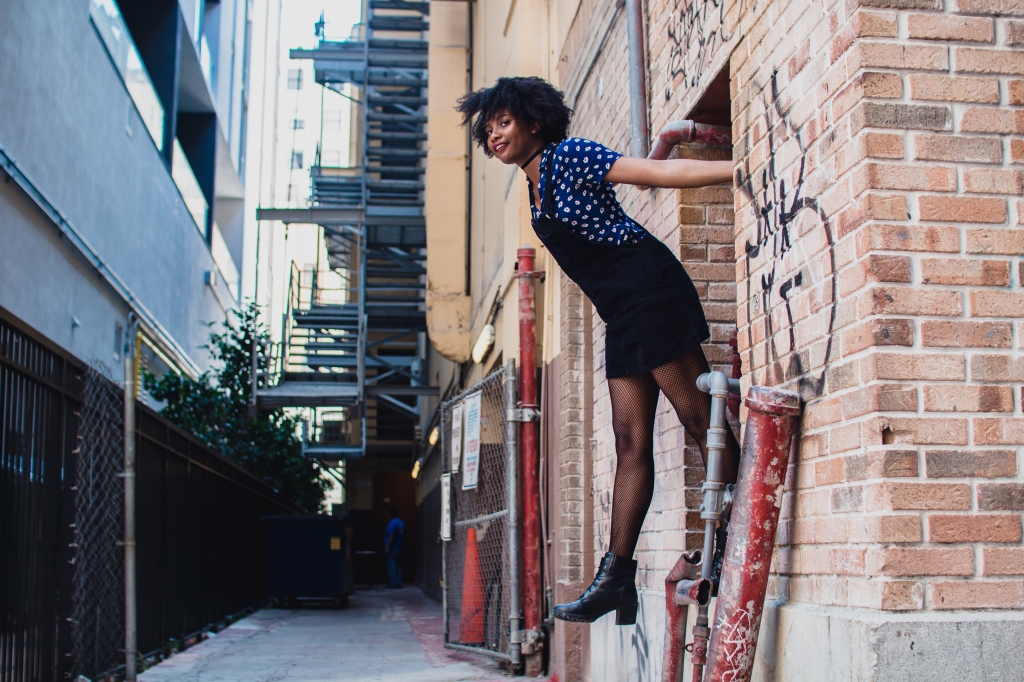
Greetings! My name is Daffodyle Saget and I am a senior graduating this spring with a degree in Sociology and English with a minor in International Communications. I have a deep love for learning especially about us as humans from the histories that form our current reality to the psychology that motivates our actions. I guess that’s why I choose sociology as a major, it helps me understand the world around me. That’s also the reason I was pushed to take this class, I wanted to understand all that makes up my current environment. Miami is my home and when you get used to something you question it less but I want to hear this cities stories and understand its problems instead of passively living here. I am so excited to learn more than I already have!
Downtown Miami as Text
“First was the Tequesta” by Daffodyle Saget of FIU in Downtown Miami
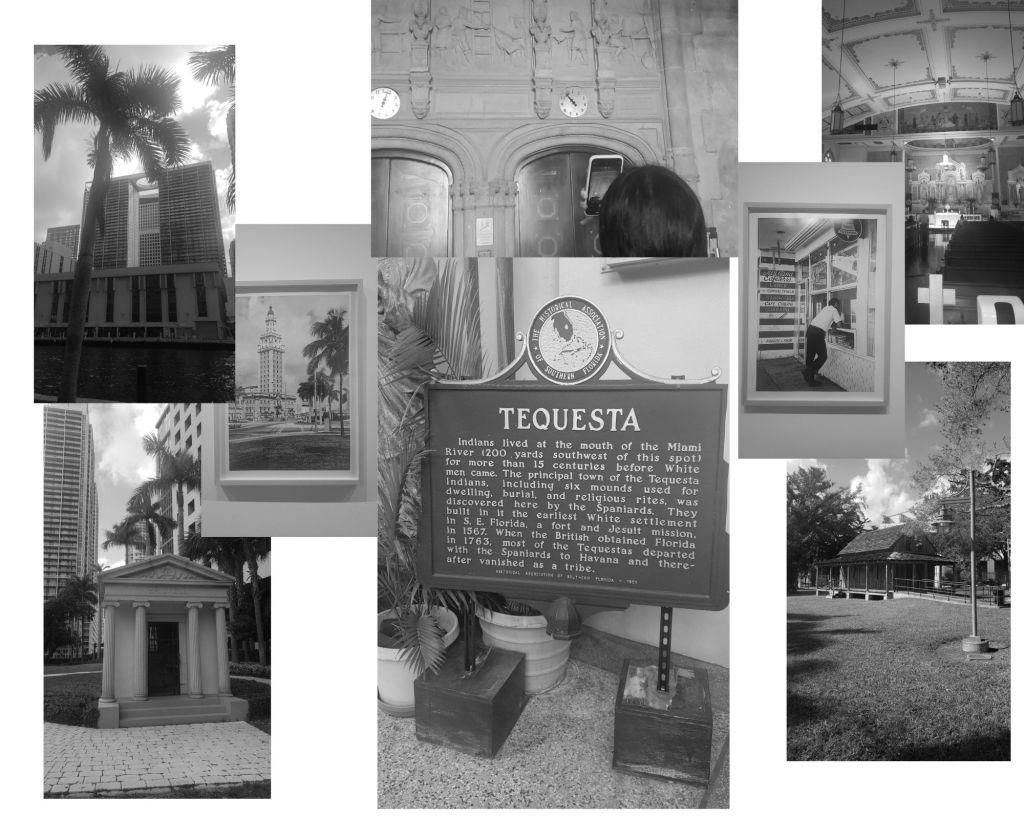
The Tequesta were first. They were the indigenous people of South Florida and what we know now as the great city of Miami. A city that is known for its diversity and its large immigrant population pouring in from all over Latin America and the world at large. But before The Cubans, The Haitians, The Bahamians, and The Europeans there were the Tequesta and it is important to start any part of American history with Native Americans.
I was so happy we began class with Professor Bailly starting this term by visiting native sites and telling their stories. Often times they are ignored when history is covered. Most people in Miami if polled on the streets would not even be able to name the indigenous people of the city even in a multiple-choice question. Professor Bailey filled in the blanks of our history classes introducing us to the Tequesta one site at a time. I learned that the Tequesta were living in Miami and all of South Florida as early as 2,000 years ago and were killed off after contact with the Spanish leaving little evidence of their culture behind. Most depictions of the Tequesta today is fictional and likely inspired by the nearby Arawaks. Most natives in the South Florida region today were pushed down from locations further north in the state and even as far north fromstates like Georgia and Alabama. The Seminole tribe itself was formed out of displaced tribes like the Miccosukee and Choctaw.
It’s devastating to think a whole people and culture was wiped out and we will never learn what life for them was truly like. To think it all started in a circle located downtown. Standing in the Miami circle where likely the center of governance was for the Tequesta and where they greeted the Europeans it was chilling to think a city would be born thousands of years later on their graves and they would become just a sad fact. People and cultures are sacred and history has a sad way of repeating itself. I left the class even sadder knowing if we don’t learn about what happened to the Tequesta and allowed what happened to them in a way happen to the African American population in Overtown, will it soon then happen to the Haitians and Cubans that create Miami culture today. With gentrification at every corner, what will Miami look like in just a few decades…
Everglades as Text
“Forgotten Miami” By Daffodyle Saget of FIU at the Everglades
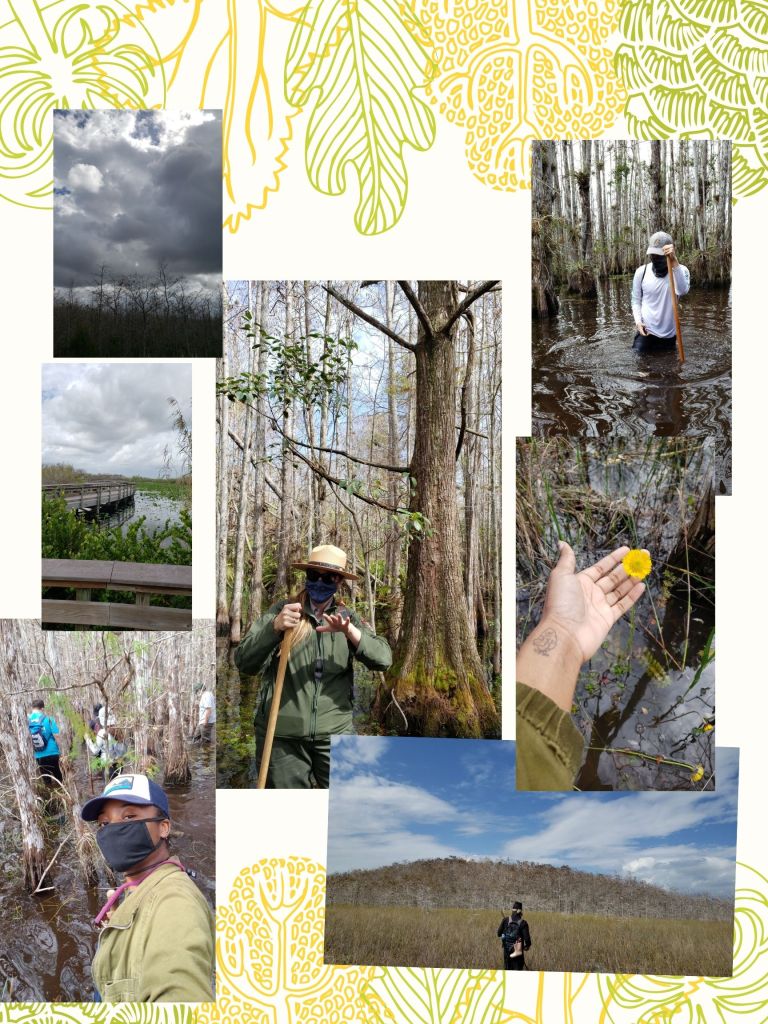
When people think of Miami images of the cities concrete white and blue skyline might flash through their heads along with the white sand beaches and palm trees. Spanish music may start playing in their mind and they may feel the humid air and taste the well-grilled meats of Latin America or a cafecito, or even a margarita. Club lights and skimpy bikinis may also fill their imagination but they probably won’t think to picture swamps, cypress trees, and alligators. I wouldn’t have thought to think of nature when it came to Miami either and I live here. Now I was knee-deep slogging through the Everglades surrounded by cypress trees as a ranger points out alligator poop on our trail. There wasn’t a concrete building in sight and I felt like I was meeting Miami for the first time.
The Everglades was always there. I knew that and so do most South Florida residents but it felt like just the abandoned backyard. Nothing occupied it but scary and gross creatures and there was nothing to do. You went there only for middle school field trips or a true country Floridian who wrestled alligators for fun. Most people from Miami have forgotten the everglades and like me until now never saw it in person. The everglades however cant be forgotten. It is part of the history and cultural heritage of Miami. This was what Miami looked like before it was industrialized, this is true Miami, Miami at its core. As we slough through professor Bailey and Ranger Dylan point out that the natural environment of a location use to shape the culture of the people living there. That forced architecture to be unique because only the trees and other natural resources available could be used. The cuisine of an area was also informed by its indigenous vegetation. Clothing would also be made from the indigenous plants and animals around. What we wore, ate, and lived in used to be of our nature. Humans used to interact with their natural environment on a daily basis becoming very much a part of it. The Tequesta build boats from the cypress I now look up at and before only knew because of the name of condos. We as residents of the city are so removed from our environment with everything imported and influence from the outside.
We have forgotten Miami and our neglect might kill her. We can’t fight for something that we don’t know to exist. It is easy to litter when you don’t see what you’re destroying daily, harmful environmental policies are easier to pass when residents don’t think it affects them, and it’s easy to see Miami as a location rather than a living environment. Instead of just moving buildings further north as the water level rises maybe we should prioritize from a young age knowing and appreciating the natural environment to prevent harm in the first place. I know sitting in that water in the shadow of the cypress connected to Miami for the first time I will fight harder knowing what I will be losing.
South Beach as Text
“South Beach the refuge” by Daffodyle Saget of FIU at South Beach

South Beach is known for many things. The iconic neighborhood is famous for its nightlife, celebrity residents, and unique architecture. Walking past the iconic landmarks amongst lively tourists living out their Miami fantasy a story unfolded amongst the art deco buildings. This place was a refuge. Not a word you would think to use for the over-exposed neighborhood where everyone’s trying to flash something either their flesh or their wealth. But Gianni Versace saw it as such and build his dream home right in the middle of it. Many queer people ran to Miami to be themselves and their legacy is visible in every other corner from the drag shows to the rainbow-painted walkways.
Miami Beach was saved by the LGBT community that came and revitalized the economically dead city in the mid-’80s. The community brought restored abandoned art deco buildings that people travel from around the world to see. South Beach became a gay mecca where people were allowed to be open and free. Decades before gay marriage was legalized men would publicly hold hand and kiss in this part of the world wherein others they risked their lives. The history of Miami can not be told without highlighting the contribution of the LGBT community. They like many groups that make up the city now found Miami to be a place they could find freedom. People come now seeking that freedom of expression the LGBT community build here and that may not exist had they not come. Covid may have taken pride this year but it’s still visible in the legacy of those first bold residents.
Deering Estate as Text
“Founders of Miami: Charles Deering” by Daffodyle Saget of FIU at Deering Estate

Photo By Daffodyle Saget ( CC By 4.0)
The Deering Estate is a manifestation of all that Charles Deering was. A lover of arts, nature, and European culture. Charles Deering unlike Flagler does not get enough attention or credit as one of the men that made Miami what it is today. However, his contributions are vital for putting the city on the map in its early years. Born in Maine in 1852 Charles began wintering in Miami as Europe closed because of World War I. Unable to take his trips he thought it would be a great idea to bring Europe to him. The 444 acres were slowly transformed with care by Deering with the purchase of the Richmond cottage. The estate became a place for his friends to come and play many of which were creatives. Charles encourages the arts with a gallery of his own that he used to spotlight artists. Its as if Charles predicted Miami would be a huge center for art with Wynwood and Art Basel being notable neighborhoods and events in the city. Charles also had a great appreciation for the nature of Miami and his residence is one of the few locations that remain largely pristine as Miami developed and erase its natural history. I got to enjoy and enveloped myself in that legacy walking through various ecosystems from wet mangroves to deserts. I personally gain alot of respect for Charles Deering for letting the Indian burial mount on the land be left untouched. The legacy of other white male developers has unfortunately also been disrespect of Native people and their culture. Another thing that Charles can get credit for is the look of Coral Gables the Italian revitalization architecture was brought to Miami because of him and now the influence is seen everywhere in the city especially the neighborhood of Coral Gables. Charles Deering’s investments and belief in this city lead him to manifest his hopes on a plot of land in the middle of nowhere Miami and it all has bared fruit.
Vizcaya as Text
“The Founders vs the Builders of Miami” by Daffodyle Saget of FIU in Vizcaya
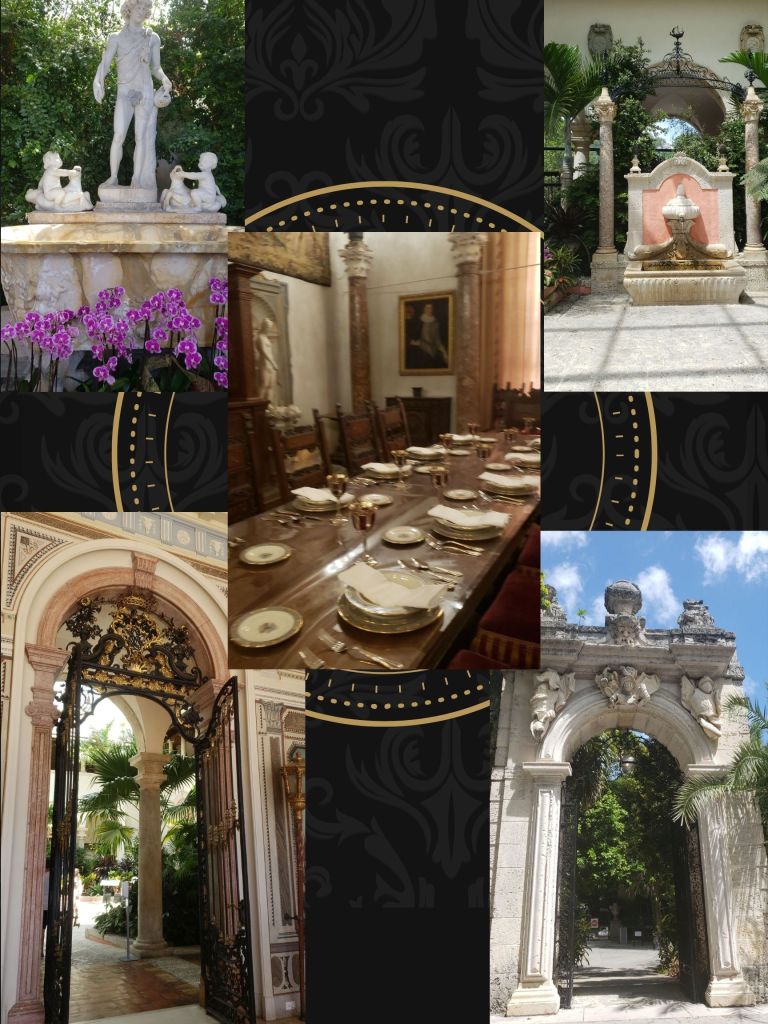
Photo By Daffodyle Saget ( CC By 4.0)
I have seen Vizcaya in many Instagram posts with people all dressed up to match the luxury and grandeur of the place. Like his brother Charles, James Deering had a vision and build it in Miami. Well, he didn’t build it and neither did Charles build Deering. Although these men are responsible for investing in Miami and setting the path for it to thrive into the city it is now. They are not the actual people that gave their lives to this city with each physical exertion. It can not be ignored that among these European mansions with imported works from France, Spain, and Italy that people come to pose and pretend next to are dead bodies. Many of the artisans that carried the bricks for Vizcaya were Black Bahamian workers. They are often lost in the story of the large estate with its porcelain sculptures of naked Europeans and sensual art creating the setting for merry times. Under each distraction of the maximalist decor is the truth of racial inequality that leads to these workers being exploited to create a getaway for another wealthy white person. It is estimated that over a thousand workers of Bahamian descent worked to build Vizcaya. They resided in the Coral Gables years before it started being developed by investors. Their knowledge of the land and skill was vital to making these ideas into real concrete buildings. Their importance is not to recognize enough in Vizcaya or any other major estate in Miami. It would have been nice to find amongst all the gilded gold interior and well-manicured landscape something paying tribute to them.
Margulies as Text
“Art as a Practice of Reflection”by Daffodyle Saget of FIU at Margulies
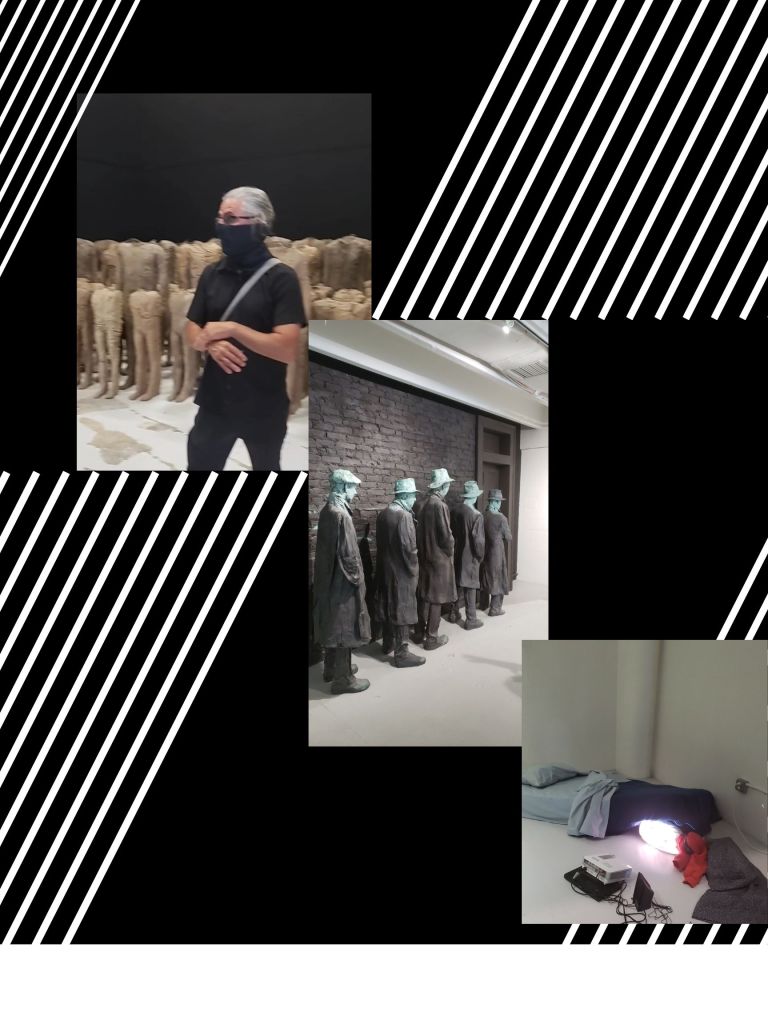
Photo By Daffodyle Saget ( CC By 4.0)
“We are living in trying times” says every mass institute email, commercial, and news station. Covid-19 has made life more difficult this past year. It robbed many of jobs, travel, community, fun, and their lives. It has forced us to reflect on the social structures in place to take care of us and also face ourselves as individuals. There hasn’t been a time in history like it. We were asked to sacrifice everything that comes naturally to us as human beings. Walking through Margulies I was reminded of other trying times in history long pass but their effects long-lasting. Magdalena Abakanowicz “Hurma” installation was one of the first I saw on the trip and it set the theme of my visit. Abakanowicz uses this piece to reflect on the holocaust and the dehumanization many faces to justify the cruelty enacted on them. The statues headless and of all shapes and sizes are a daunting view that overwhelms you. Another era of great loss in human history survived to be told. This theme continues as another tragedy is told with the breadline statues by George Segal. The great depression was another time people lost life as they knew it practically overnight. Structures in place failed us and the damage forced a generation to reassess their values. One of the last installations I saw was a woman projecting her distraught image onto a balloon head that was attached to a small body hidden under a bed. The piece expresses personal suffering which in “trying times” we are all familiar with to some degree. I left wondering what art will be made to reflect and heal from this pandemic and connect to future generations. I’m sure the mask will be in heavy use in those installations.